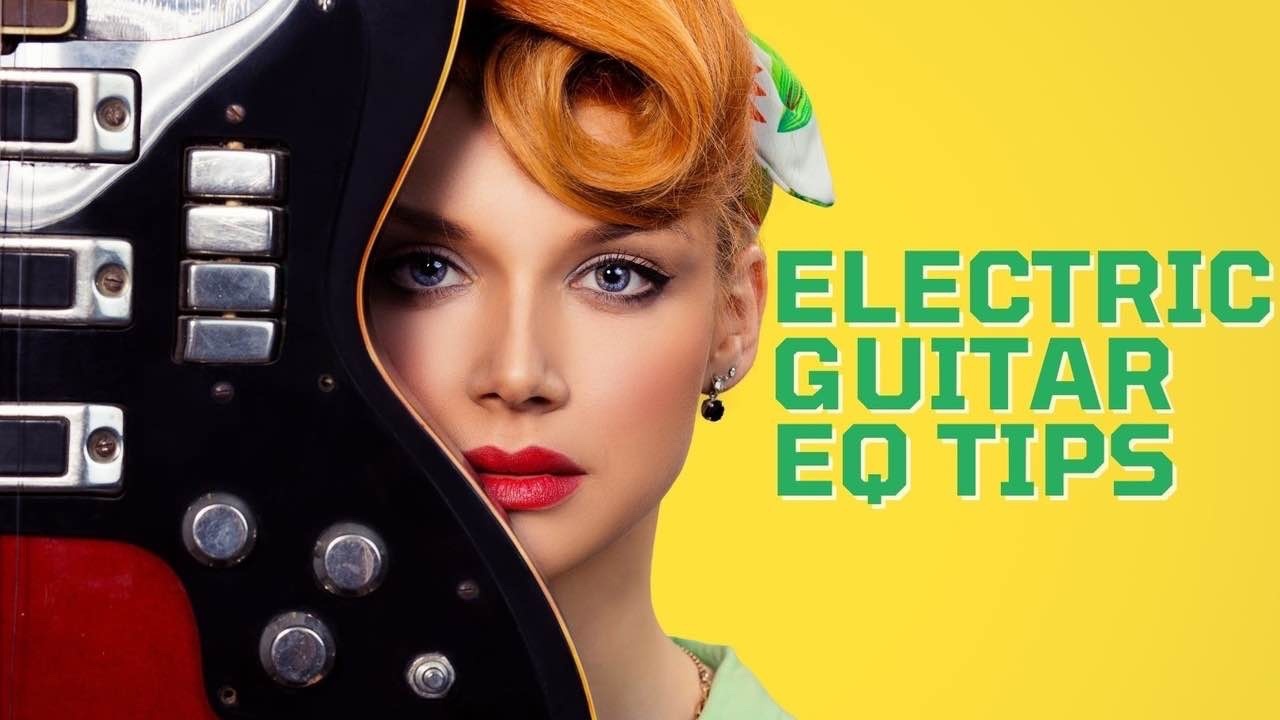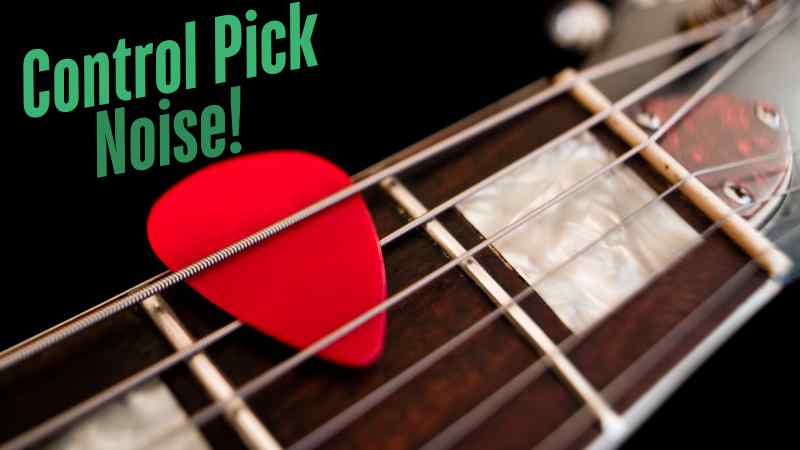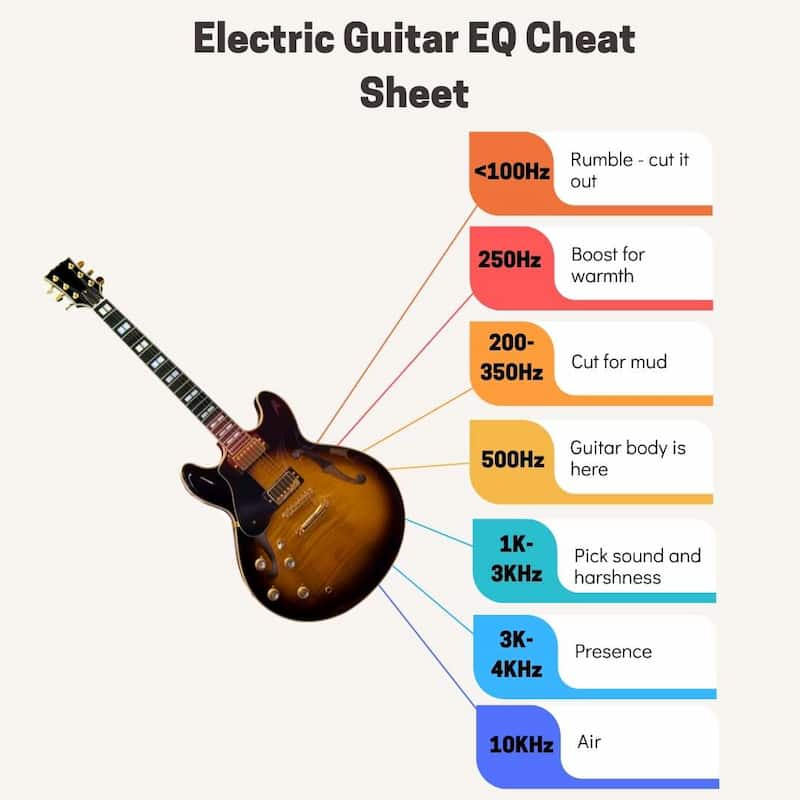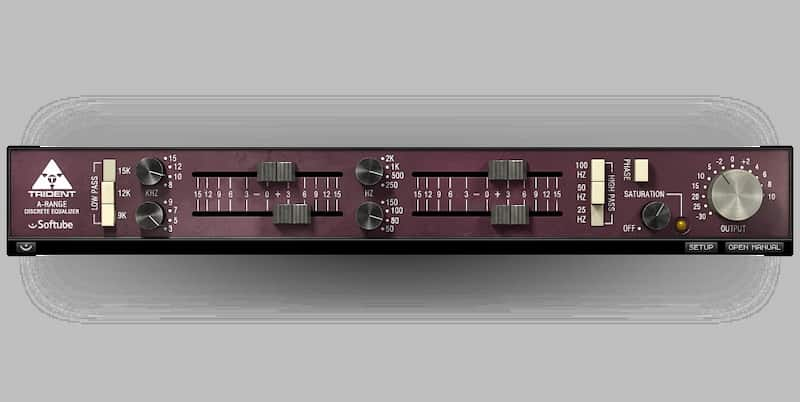Electric Guitar EQ Tips

When it comes to electric guitar, the range of possible sounds is MASSIVE. But I literally wrote the book on using EQ, so you're in good hands!
A heavily distorted, nu-metal guitar requires vastly different processing than a clean, ambient guitar drenched in cavernous reverb. Of course, if your electric guitar is part of a larger mix, you will likely need to EQ certain parts of it to help it fit in its own space.
Today, we’re going to dive in and explore the ins and outs of EQing this diverse instrument so you can get one step closer to professional mixes.
And at the end of this article, you'll find a free Electric Guitar EQ Cheat Sheet that you can right click to download!
Note: this article may contain affiliate links, which mean that I receive a commission for any purchases you make, at no added cost to you.
EQing Electric Guitar Process

There are a few steps you should take before you reach for the EQ on your electric guitar tracks. Here are out favorites. In fact, before you start playing, you should get your sound as close to perfect as possible. Choose the right guitar, the right pickup and tone control settings.
Tweak your amp and pedals. Decide whether you should be picking closer to the neck or the bridge.
Starting with a good sound will make the process of EQing so much easier!
And if you're looking for that perfect EQ plugin, we've put together a review of the 6 best EQ plugins!

High and Low-Pass Filters
It’s typically a good idea to filter out the low lows and the high highs when EQing electric guitar. The low-end, typically under 80Hz, is nothing but rumble and noise. Chop it out in a dense mix to make room for the kick and bass.
On the other end of the spectrum, you can typically get rid of fizzy highs using a low-pass filter. Depending on the guitar, I’ll sometimes bring this down to 7kHz. It is up to YOU to listen to how dark you want to make your acoustic guitar, if at all.
Remove Mud from Electric Guitar
Mud usually lies anywhere from 250Hz to 350Hz. Too much mud and your mix can sound flat and lifeless. Depending on the guitar recording, you might consider cutting this area to create a bit more clarity.
However, take caution when cutting in this area. Too often, amateur mixers will make deep cuts in this area to create mix clarity, though they don’t realize they’re removing all of the body and life that makes up the low-end of the guitar.
Remove Harshness & Resonances
To get rid of resonances and harshness, you might need to sweep around to find the specific frequencies that are annoying to you. To do this, use a narrow Q value, boost by around +10dB, and sweep around the frequency spectrum until you find a resonance that sticks out in a negative way.
Often, these resonances come from the room or the amp cabinet.
You can use this same method to get rid of harshness. I recommend that you start your harshness search in the 1kHz to 3kHz range, as that is where it usually lies.
Enhance the Guitar Tone with EQ
How you choose to enhance your electric guitar truly depends on what it needs.
For a heavy rock mix, you might want to add more body to your electric guitar. In that case, you could maybe try a wide boost of around 3dB anywhere from 300 to 500Hz. This range is where the fundamentals of most electric guitars sit.
On the other hand, you might have a guitar solo that needs a bit more presence. In this case, you could try a wide boost anywhere from 3kHz to 5kHz to help it cut through the mix.
When it comes to enhance a guitar with EQ, the best EQ is probably SofTube's emulation of the Trident A-Range, a legendary EQ used by everyone from David Bowie to Metallica.
Useful Electric Guitar EQ Frequencies
We've put together a list of some of the most important to reach for when something sounds off with your guitar tone.
Reduce String Noise or Increase It using EQ
Whether you’re dealing with a little too many squeaks in your guitar recording or a guitar tone that sounds borderline cheap VST status, you can add or decrease string noise as you deem necessary by looking in the 2kHz to 5kHz range.
I recommend automating your EQ if you’re trying to get rid of string noise so that it only dips out when the string noise is present, not throughout the entire song.

Increase Pick Attack or Decrease It with EQ
If you’re looking to increase or decrease pick attack, I would recommend using a transient shaper rather than EQ. However, you can also look in the 1kHz to 2kHz range to manipulate your guitar’s pick attack.
Boosting pick attack can be especially useful if you’re mixing a heavy song and the guitarist didn’t play with a ton of confidence.
Reduce Distortion Hum
Distortion hum typically lies on the low end under 80Hz. If you’re looking to get rid of it for a busy mix, we recommend using a high-pass filter. You can pair that high-pass filter with a noise gate to get rid of any distortion hum while the guitar isn’t playing.

Metal Guitar EQ Settings
There are many ways to EQ a metal guitar, though many metal guitarists adhere to the smiley EQ. Start by getting rid of any unnecessary low-end to make room for the kick and bass. Next, listen for where the muddy build-up is (typically between 200Hz and 500Hz) and dip it out using a wide Q setting so that your EQ looks like a smiley face.
You can also chop off any fizzy high-end by using a low-pass filter down to anywhere from 4kHz to 10kHz. For these types of boosts, the Trident A-Range EQ will help you bring out a warm edge to your guitar without it sounding harsh.
Electric Guitar EQ Tips
These are some of our favorite electric guitar EQ tips that will help you preserve your tone, while bringing out the bite that you're after.
Use a Dynamic EQ
Dynamic EQ can be useful in so many ways. Whether your guitar has string noise during very specific parts, only gets muddy when you play certain notes, or needs a bit more beef to stabilize the tone when you move from a low chord to a high chord, you can use dynamic EQ.
The beauty of dynamic EQ is that it changes throughout the song and adapts to the sound. We recommend the FabFilter Pro-Q4.
Here is a straightforward guide for How to Use Dynamic EQ.
Add Mid/Side Processing for Width
To add width with mid/side processing, I recommend cutting the lows on the sides (somewhere up to 100Hz to 200Hz) and boosting the low frequencies in the middle. In doing so, you can get rid of any muddy build-up that could reduce the stereo image of your mix, while making your guitar sound fatter and larger in the middle without impacting the overall balance of your mix.
If you have bright cymbals or any other bright stereo instruments, you can also cut the high-end of your guitars on the sides using a high shelf. Again, we recommend the FabFilter Pro-Q 4 for subtle mid-side adjustments.
Here's my straightforward guide with some killer tips on how to use mid-side EQ on guitar.
Questions about Electric Guitar EQ?
Please let me know in the comments below if you've got any questions on electric guitar EQ! I'll be sure to respond to them!
Also, if you've got an tips/tricks for EQing guitar that I've missed, please suggest them!
Understanding The Electric Guitar Frequency Range
The frequency range for an electric guitar recorded with an amplifier can extend anywhere from 80Hz (depending on how low you tune your bottom string) to around 4.5kHz.
Now, of course, if you look at a frequency analyzer, you’ll see plenty of frequency content above 4.5kHz, though most of that frequency content isn’t very important when it comes to electric guitar.
In fact, most of the frequency content above 7kHz is fizz, especially when it comes to distorted electric guitar. More often than not, you’ll want to focus on the low mid-range for rhythm guitars, anywhere between 150 to 500Hz, and anywhere between 3 to 5kHz for lead guitars, especially if you’re trying to get them to cut through a dense mix.

Here’s a small breakdown of the frequencies you should look at when you’re trying to EQ electric guitar:
- 100Hz - Most everything under 100Hz is low-end rumble and noise
- 250Hz - If you’re trying to add warmth to your electric guitar, this is a great place to look.
- 200Hz - 350Hz - Expect to find mud here, especially on heavily distorted guitars.
- 500Hz - This is where the body of most electric guitars lies.
- 1kHz-3kHz - To increase or decrease pick sound, look here. This area is also where harshness lies.
- 3kHz-4kHz - You can use this region to push the guitar upfront and make it more present in a mix.
- 10kHz - If you want to give a clean electric guitar more air, try a high shelf up here.
How to use EQ Guides
To help you get the most out of your EQ plugins, we've put together these detailed guides to teach you how to use EQ on some of the most popular instruments.
- How to Mix with EQ
- Tips for EQing piano
- Electric guitar EQ tips
- How to EQ acoustic guitar
- How to EQ bass guitar
- How to EQ drums
- How to EQ vocals
- How to EQ woodwinds
- How to EQ strings
- How to Use Mid-Side EQ
- 3 Powerful Ways to Use Dynamic EQ
- How to EQ Loops
- How to EQ Reverb
- How to EQ Percussion
FAQ for Guitar EQ
1. What’s the difference between parametric, graphic, and shelving EQ?
- Parametric EQ lets you select exact frequencies and adjust their gain and bandwidth (Q).
- Graphic EQ has fixed frequency bands with sliders for each.
- Shelving EQ boosts or cuts all frequencies above or below a set point.
2. Should I EQ my guitar before or after distortion?
Before distortion affects the raw tone; after distortion helps shape it for the mix. Try both and see what works best.
3. How do I make my guitar sound bigger?
- Use a subtle low-end boost around 150Hz, but don’t overdo it.
- Add a slight presence boost around 3kHz - 5kHz to enhance attack.
- Double-track recordings for a stereo spread effect.
4. How do I use EQ in a live setting?
- Cut low frequencies (below 100Hz) to prevent boominess.
- Boost midrange (1-4kHz) so your guitar cuts through the band.
- Roll off highs (above 10kHz) if there's too much fizz.
From a Frustrated Producer in a Ragtag Bedroom Studio to Major Placements on TV Earning $1,000s!
My name is Evan, and I've been making music since around 3rd grade. I'm from San Diego, California, but I've lived in Washington, DC for the last 20 years.
While I still have a full-time day job, I have created systems that have allowed me to produce dozens of songs a year in my spare time.
My songs have been on Netflix, TV shows like the 90 Day Fiance, an award-winning indie film, and NPR’s “All Thing Considered.” They've also been streamed millions of times.
In addition to being a music producer, I am passionate about teaching people how they can make professional-sounding music and earn money licensing it, all in their spare time.
Thousands of musicians, like yourself, have trusted me to guide their musical journey. My YouTube videos have been watched nearly a million times. And my story has been in Forbes, Side Hustle Nation, and the Side Hustle School.







